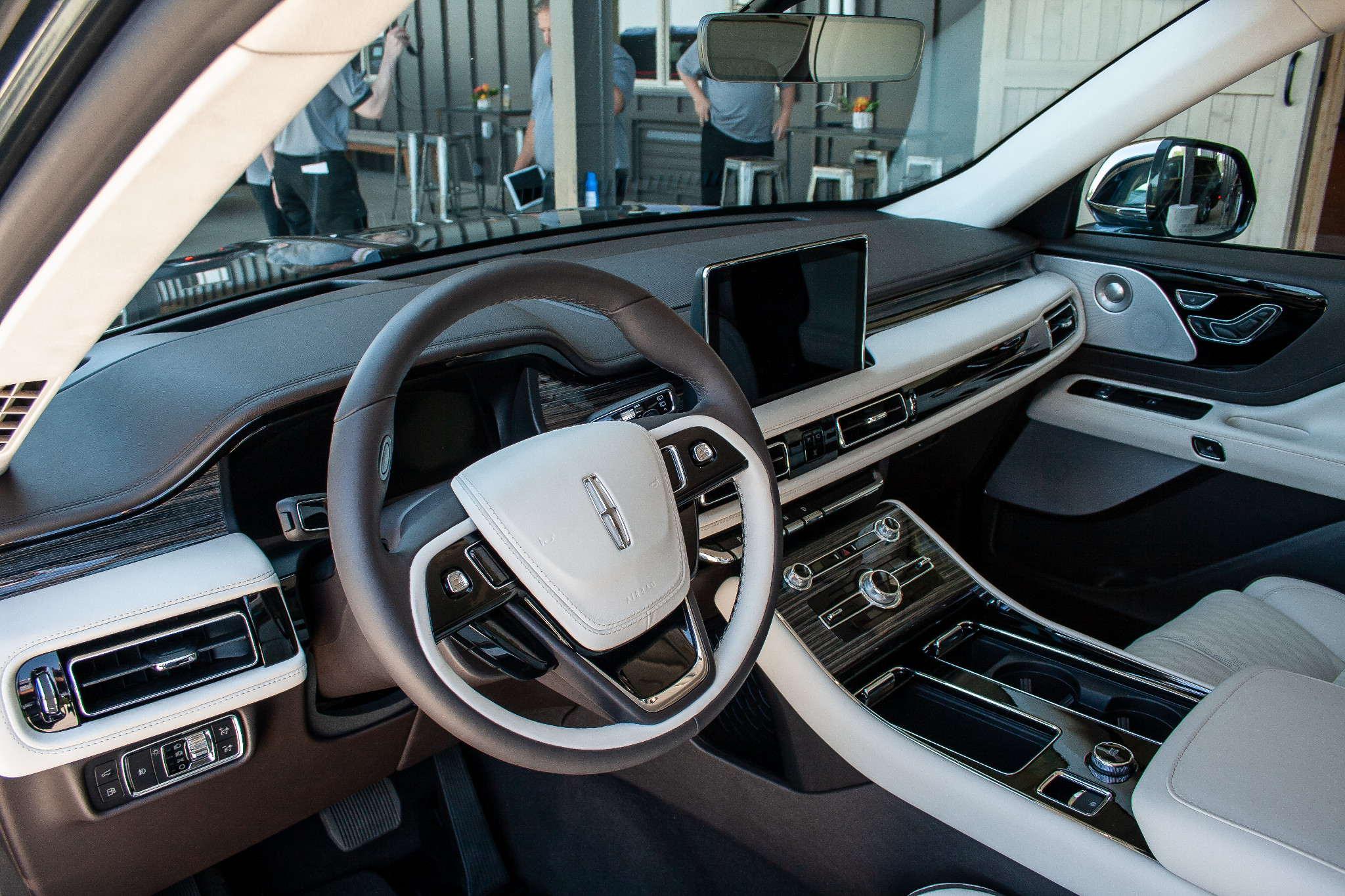
2021 Lincoln Aviator: Luxury-Plus in Quiet, Powerful Mid-Size SUV
With only minor changes to appearance packages, including optional 21- and 22-inch wheel designs, three new colors (Asher Gray, Ocean Drive Blue, and Flight Blue), and an available Monochromatic Reserve appearance package. The one-year-old second-Gen Lincoln Aviator remains a leader in American mid-size SUV luxury, with a nod to its sibling, the full-size Navigator, but in a smaller, and more maneuverable package.
Aviator was launched from 2003 through 2005 as a rebadged version of the Mercury Mountaineer, and after a 15-year hiatus, returned last year as a mid-size five-door, three row luxury SUV.
Based on the Ford Explorer, Aviator has its own upscale styling, sculpting, engine, chassis makeup and tech. Aviator focuses on luxury and elegance, and is its own creation, not to be likened to any other in the brand.
The creation of the second-gen Lincoln Aviator was tasked with merging elegance, styling, performance and advanced technology, while advancing an electrified hybrid system. With a gas-powered 400hp /415 lb-ft of torque engine and a plug-in hybrid system that provides 494hp and best-in-class 630 combined lb-ft of torque, Aviator is built for power and capability joining with sleek elegance and intuitive technology.

Aviator provides Lincoln’s “Quiet Flight,” which combined performance with silence. Aviator offers those two powertrains – a standard twin-turbocharged 3.0-liter V6 gas engine and the Grand Touring’s hybrid powertrain. Aviator vanguarded Lincoln’s approach to a twin-turbocharged 3.0-liter V6 engine and advanced electrified hybrid technology capable of delivering smooth performance and quick-acting torque.
Avaiator’s architecture and styling is a direct turn off its name and is marketed with a sky-driven approach. Company literature says, “The boundless allure of flight has long inspired automotive design, and the exterior styling of the all-new Lincoln Aviator takes that inspiration to the next level. The connotations of flight are intrinsic in the strong front and tapering rear of the vehicle, creating a distinct aerofoil analogy,” according to Lincoln’s pitch. Exterior dimensions are 199.3 inches in length, a wind-attracting 69.6 inches in height and 82.3 inches in width on a 119.1-inch wheelbase, for a curb weight of from 4774 to 5673 lbs. depending on trim level and configuration. My Reserve trim weighed about 5020 lbs.
Aviator’s cabin is packed with luxury appointments and comfort, a 14-speaker audio system with voice-activated touch-screen navigation system, three rows of seating, available concert hall sound, intuitive tech and function and a quiet environment of quality. The comfortable cabin provides, 41 inches of front headroom (40.2 with a Vista Roof), 39.7 inches in row two and a tight 36.9 inches in row three. Aviator provides 43 inches of front legroom, with 40.1 in the middle and a child-only 29.2 inches in the rear seats; and 61.5 inches of front shoulder room with 61.3 in row two and 54.0 in row three.
Interior climate control includes a Particulate Air Filter Tri-Zone Climate Control, with second row climate controls (with Audio and Heated/Vented Seat Controls when equipped). You also get a 10.1-inch LCD touch-screen in the center-stack, Ambient interior lighting, delayed Accessory Lighting in the first row, Lincoln Connect™ with 4G embedded modem with WiFi® hot spot capability, that enables Lincoln Way™ App remote features (when activated) and so much more we can’t do justice to listing them here.
Aviator drives quietly, attentively and smoothly in both Front-wheel-drive and Intelligent All-wheel-drive configurations. My test Aviator Reserve in AWD was outfitted with the twin-turbocharged 3.0-liter V6 Engine with Stop-Start Technology. EPA rated at 27mpg/highway, 20mpg/city and 24mpg/combined, my rides delivered 22.4mpg. With the hybrid option, Aviator Grand Touring’s twin-turbocharged engine and advanced electrified technology shows some hesitation, but increases gas mileage by up to 20 miles when all-electric.
My test ride’s 400hp system, did not delay and the response was seamless, sprinting to a 6.1-second zero-to-60mph dash, and a quarter-mile of 14.8 seconds. On the open road, Aviator delivers a quiet, powerful, confident ride. Driver and passengers are pampered by its adaptive suspension. Aviator’s Electric Power-Assisted Steering is predictable and while there is some top-wobble during quick maneuvers, Aviator is confident in turns.
Aviator’s safety systems include Blind Spot Detection with Cross-Traffic Alert, enhanced by Driver and Front Passenger Dual Stage, Side Impact, and Glove-Box-Door Integrated Knee Airbags. The Safety Canopy/Air Curtain (3-rows) with roll-over sensor adds to security as do Vehicle Inclination Sensor Remote, Keyless Entry SecuriCode™ (Keypad), SecuriLock® Passive Anti-Theft System, SOS Post-Crash Alert, Tire Pressure Monitoring System and Emergency Brake Assist Four-Way Adjustable Head Restraints.
The 2021 Lincoln Aviator starts at $51,465 for the base Standard trim, followed by the Reserve trim at $57,355, upgrading with 20-inch wheels, quad-zone climate control, optional packages including Lincoln Co-Pilot360™ Plus and more. The Aviator Grand Touring offers the rechargeable electric hybrid powertrain added to the standard Twin-Turbocharged engine, and keeps Reserve’s features, at $68,360. Aviator’s Black Label top trim starts at $79,350 with special themes, interior finishes and exclusive member service items. My Reserve saved me $2390 by going to AWD and removing some Reserve Package. Burgundy Velvet exterior paint added $695 and running boards added $1065.
The Premium interior package for the Panoramic Vista Roof® with Power Sun Shade, added $1500 and voice-activated touchscreen navigation added $500. With Destination charges of $1195 and an Acquisition Fee of $645, my sticker came to $59,065, but available incentives of up to $925 may be available, so check with your dealer.
> Visit www.CarlisleEvents.com for more on the automotive hobby.
Mike Blake, former editor of KIT CAR magazine, joined Carlisle Events as senior automotive journalist in 2004. He's been a "car guy" since the 1960s and has been writing professionally for about 30 years. </I>
Aviator was launched from 2003 through 2005 as a rebadged version of the Mercury Mountaineer, and after a 15-year hiatus, returned last year as a mid-size five-door, three row luxury SUV.
Based on the Ford Explorer, Aviator has its own upscale styling, sculpting, engine, chassis makeup and tech. Aviator focuses on luxury and elegance, and is its own creation, not to be likened to any other in the brand.
The creation of the second-gen Lincoln Aviator was tasked with merging elegance, styling, performance and advanced technology, while advancing an electrified hybrid system. With a gas-powered 400hp /415 lb-ft of torque engine and a plug-in hybrid system that provides 494hp and best-in-class 630 combined lb-ft of torque, Aviator is built for power and capability joining with sleek elegance and intuitive technology.

Aviator provides Lincoln’s “Quiet Flight,” which combined performance with silence. Aviator offers those two powertrains – a standard twin-turbocharged 3.0-liter V6 gas engine and the Grand Touring’s hybrid powertrain. Aviator vanguarded Lincoln’s approach to a twin-turbocharged 3.0-liter V6 engine and advanced electrified hybrid technology capable of delivering smooth performance and quick-acting torque.
Avaiator’s architecture and styling is a direct turn off its name and is marketed with a sky-driven approach. Company literature says, “The boundless allure of flight has long inspired automotive design, and the exterior styling of the all-new Lincoln Aviator takes that inspiration to the next level. The connotations of flight are intrinsic in the strong front and tapering rear of the vehicle, creating a distinct aerofoil analogy,” according to Lincoln’s pitch. Exterior dimensions are 199.3 inches in length, a wind-attracting 69.6 inches in height and 82.3 inches in width on a 119.1-inch wheelbase, for a curb weight of from 4774 to 5673 lbs. depending on trim level and configuration. My Reserve trim weighed about 5020 lbs.
Aviator’s cabin is packed with luxury appointments and comfort, a 14-speaker audio system with voice-activated touch-screen navigation system, three rows of seating, available concert hall sound, intuitive tech and function and a quiet environment of quality. The comfortable cabin provides, 41 inches of front headroom (40.2 with a Vista Roof), 39.7 inches in row two and a tight 36.9 inches in row three. Aviator provides 43 inches of front legroom, with 40.1 in the middle and a child-only 29.2 inches in the rear seats; and 61.5 inches of front shoulder room with 61.3 in row two and 54.0 in row three.
Interior climate control includes a Particulate Air Filter Tri-Zone Climate Control, with second row climate controls (with Audio and Heated/Vented Seat Controls when equipped). You also get a 10.1-inch LCD touch-screen in the center-stack, Ambient interior lighting, delayed Accessory Lighting in the first row, Lincoln Connect™ with 4G embedded modem with WiFi® hot spot capability, that enables Lincoln Way™ App remote features (when activated) and so much more we can’t do justice to listing them here.
Aviator drives quietly, attentively and smoothly in both Front-wheel-drive and Intelligent All-wheel-drive configurations. My test Aviator Reserve in AWD was outfitted with the twin-turbocharged 3.0-liter V6 Engine with Stop-Start Technology. EPA rated at 27mpg/highway, 20mpg/city and 24mpg/combined, my rides delivered 22.4mpg. With the hybrid option, Aviator Grand Touring’s twin-turbocharged engine and advanced electrified technology shows some hesitation, but increases gas mileage by up to 20 miles when all-electric.
My test ride’s 400hp system, did not delay and the response was seamless, sprinting to a 6.1-second zero-to-60mph dash, and a quarter-mile of 14.8 seconds. On the open road, Aviator delivers a quiet, powerful, confident ride. Driver and passengers are pampered by its adaptive suspension. Aviator’s Electric Power-Assisted Steering is predictable and while there is some top-wobble during quick maneuvers, Aviator is confident in turns.
Aviator’s safety systems include Blind Spot Detection with Cross-Traffic Alert, enhanced by Driver and Front Passenger Dual Stage, Side Impact, and Glove-Box-Door Integrated Knee Airbags. The Safety Canopy/Air Curtain (3-rows) with roll-over sensor adds to security as do Vehicle Inclination Sensor Remote, Keyless Entry SecuriCode™ (Keypad), SecuriLock® Passive Anti-Theft System, SOS Post-Crash Alert, Tire Pressure Monitoring System and Emergency Brake Assist Four-Way Adjustable Head Restraints.
The 2021 Lincoln Aviator starts at $51,465 for the base Standard trim, followed by the Reserve trim at $57,355, upgrading with 20-inch wheels, quad-zone climate control, optional packages including Lincoln Co-Pilot360™ Plus and more. The Aviator Grand Touring offers the rechargeable electric hybrid powertrain added to the standard Twin-Turbocharged engine, and keeps Reserve’s features, at $68,360. Aviator’s Black Label top trim starts at $79,350 with special themes, interior finishes and exclusive member service items. My Reserve saved me $2390 by going to AWD and removing some Reserve Package. Burgundy Velvet exterior paint added $695 and running boards added $1065.
The Premium interior package for the Panoramic Vista Roof® with Power Sun Shade, added $1500 and voice-activated touchscreen navigation added $500. With Destination charges of $1195 and an Acquisition Fee of $645, my sticker came to $59,065, but available incentives of up to $925 may be available, so check with your dealer.
> Visit www.CarlisleEvents.com for more on the automotive hobby.
Mike Blake, former editor of KIT CAR magazine, joined Carlisle Events as senior automotive journalist in 2004. He's been a "car guy" since the 1960s and has been writing professionally for about 30 years. </I>
Book with a preferred Hotel
Book online or call (800) 216-1876









Leave a commentOrder by
Newest on top Oldest on top